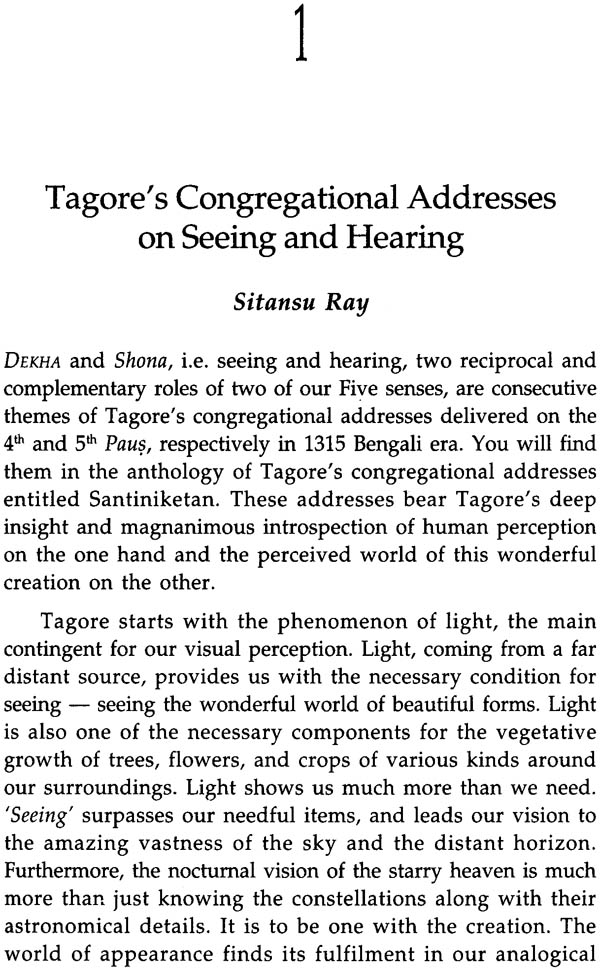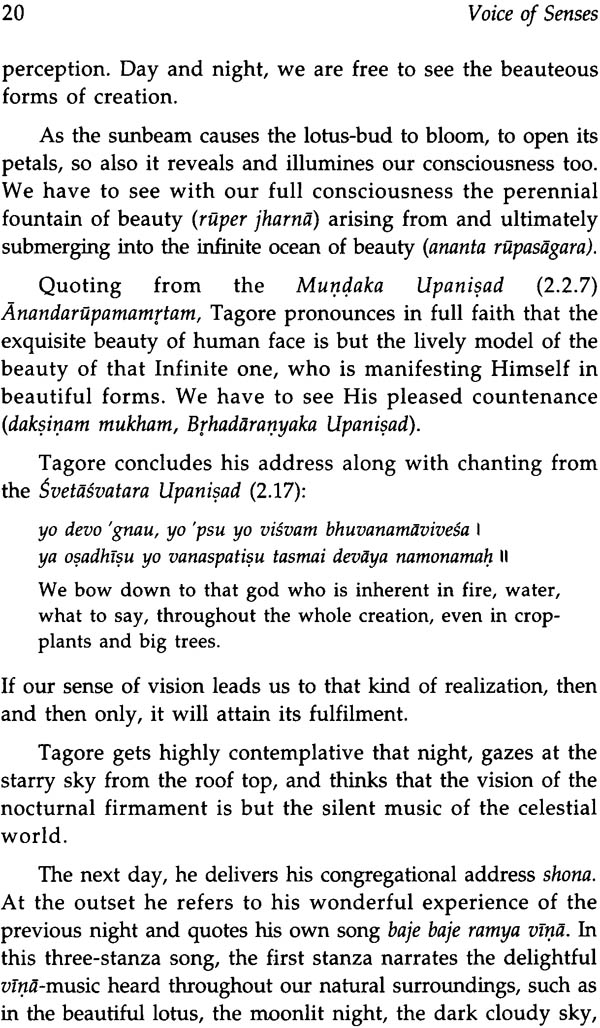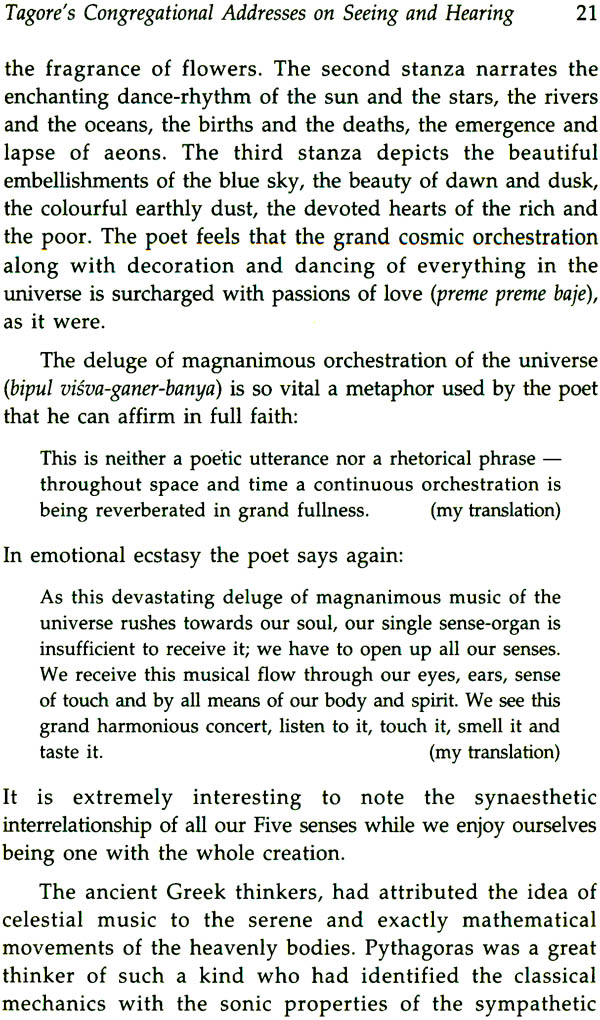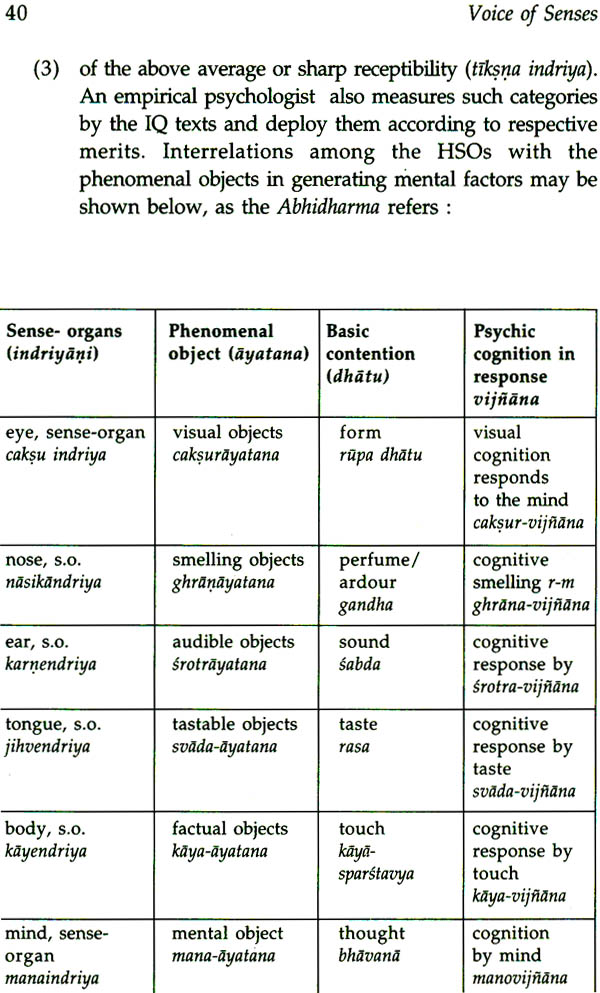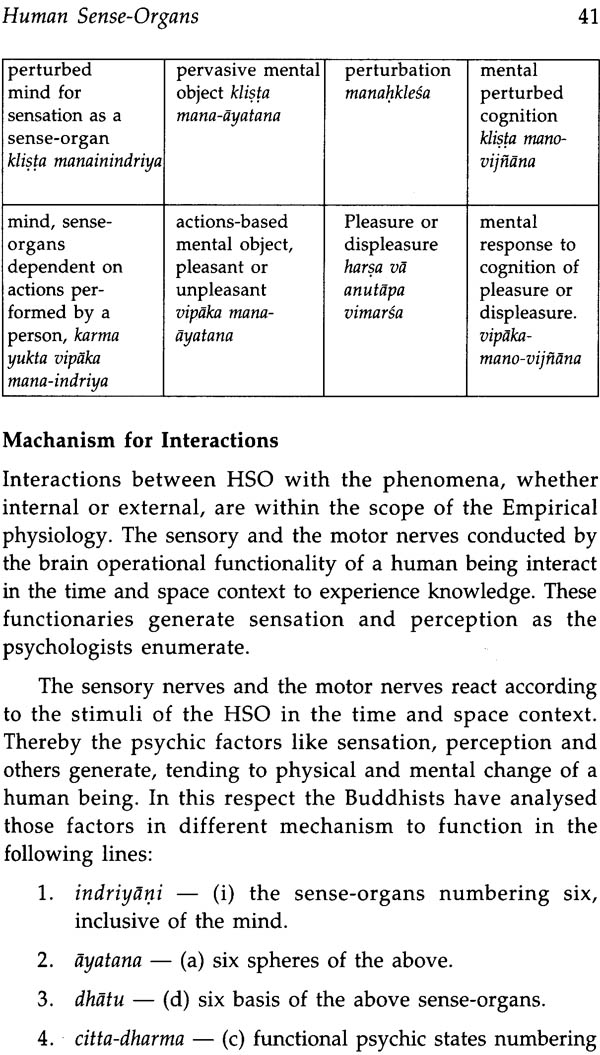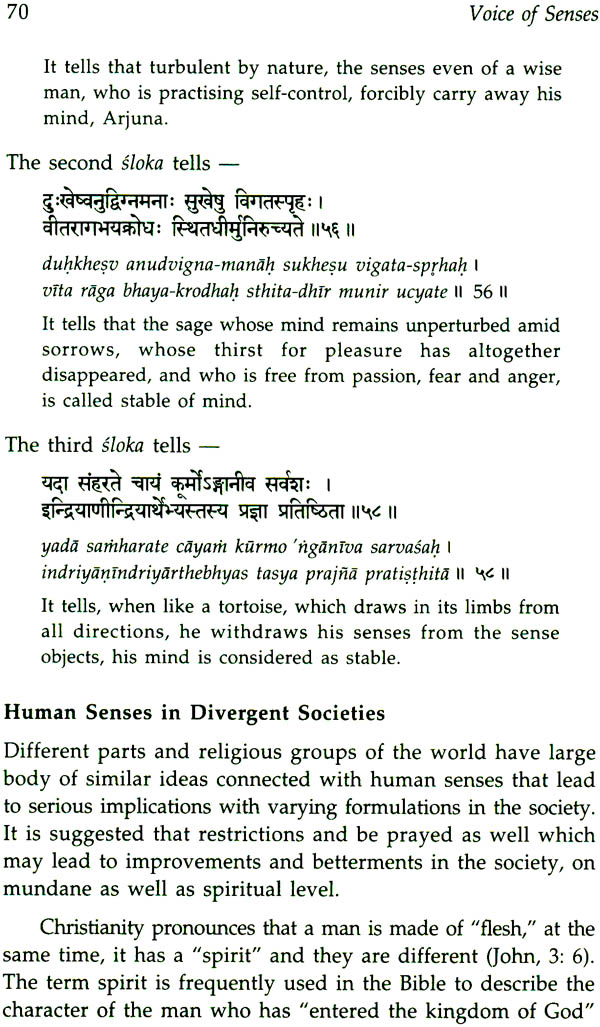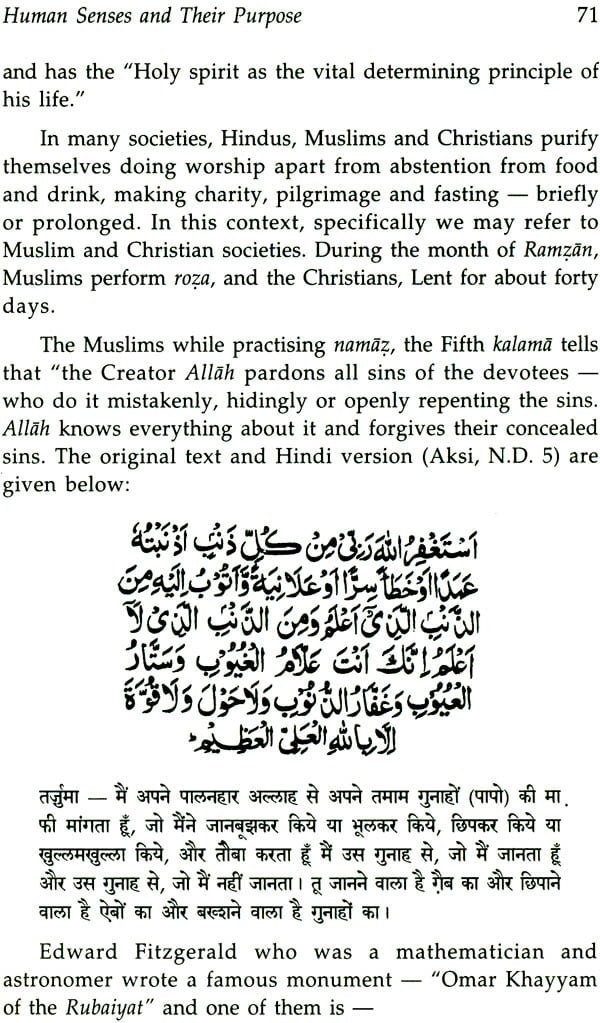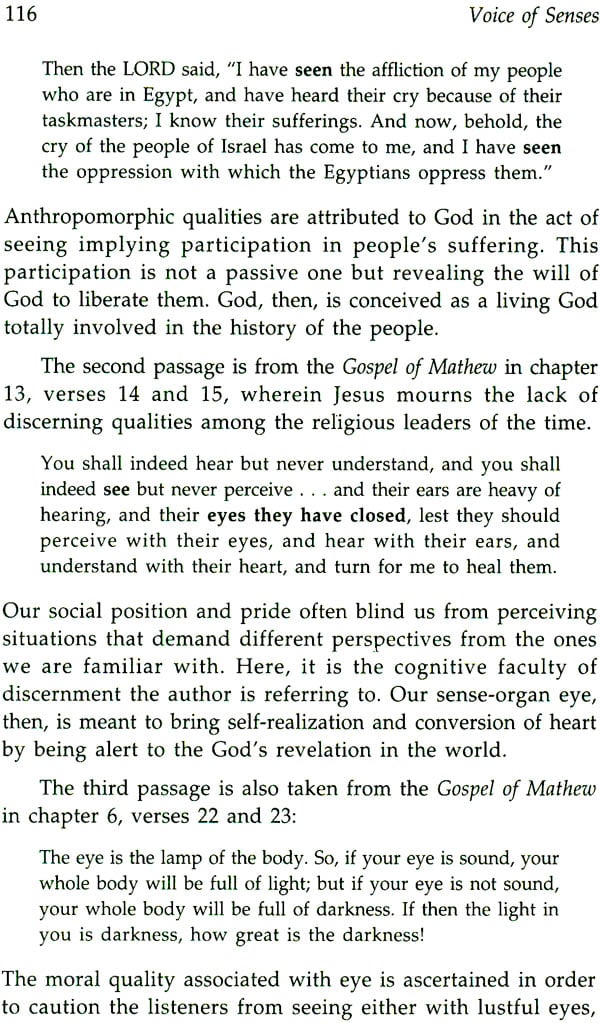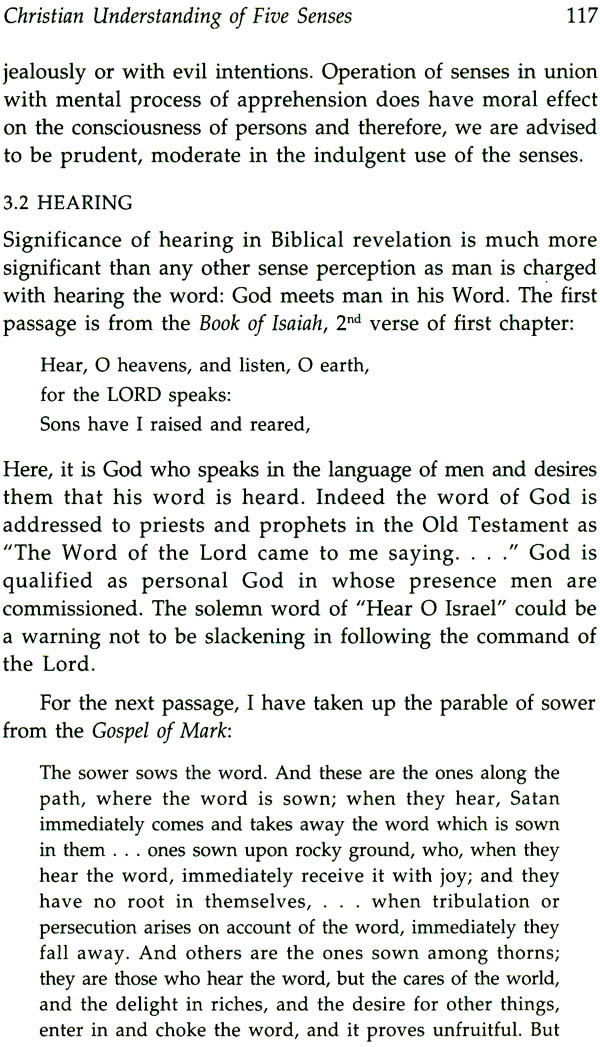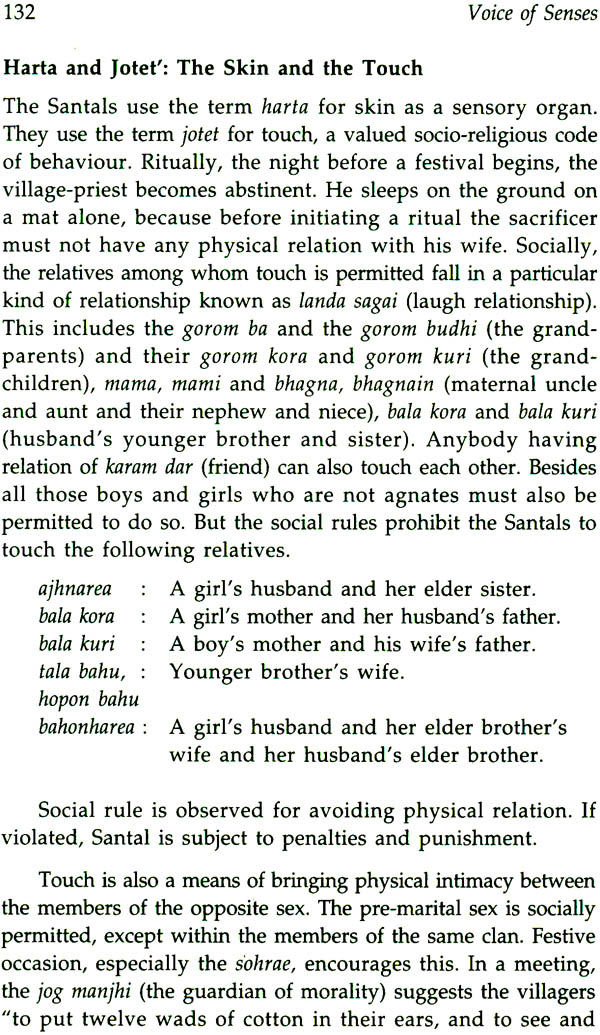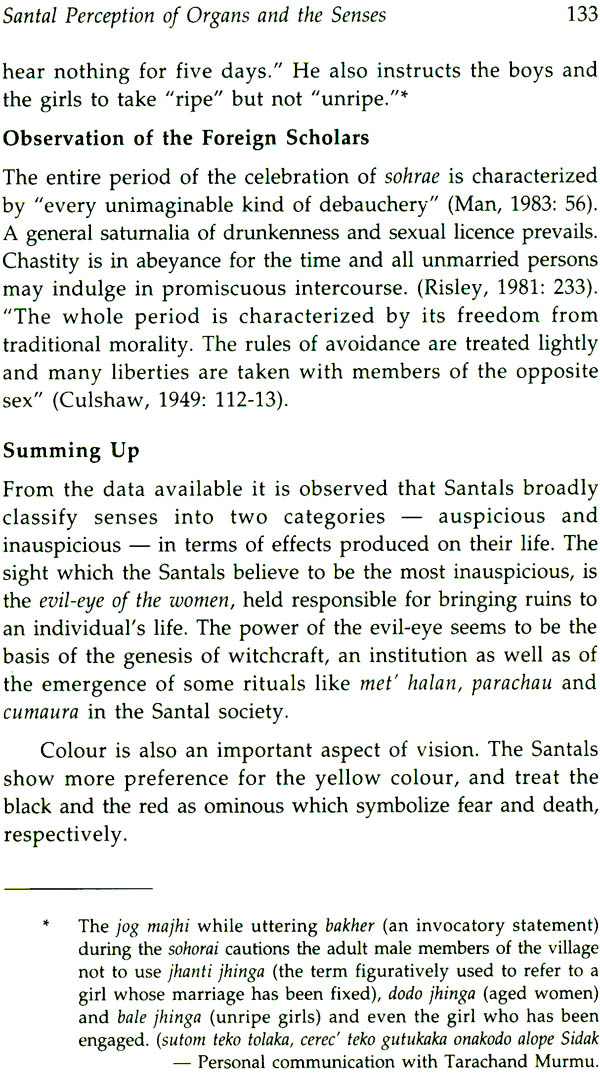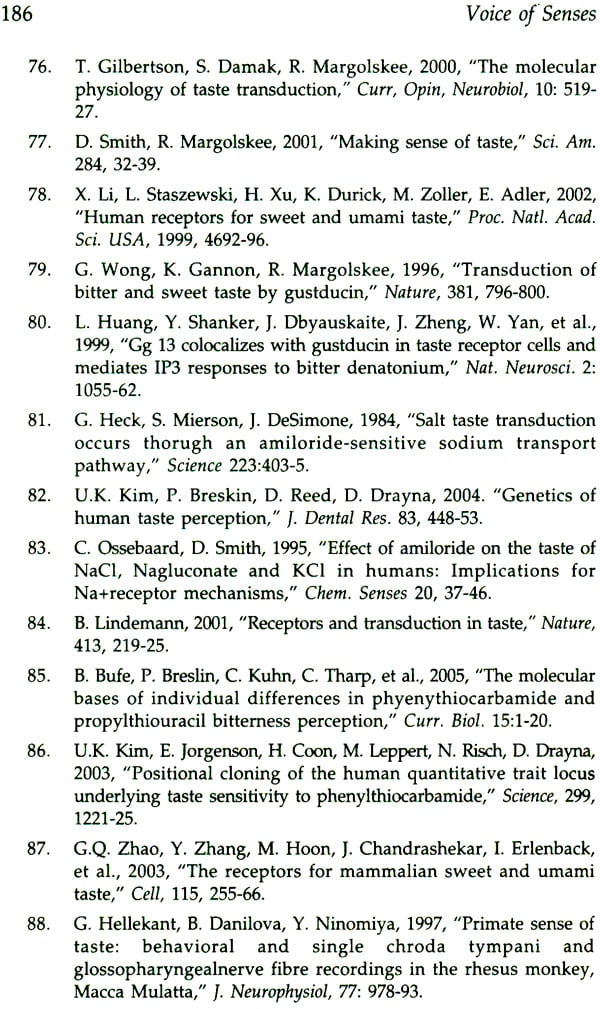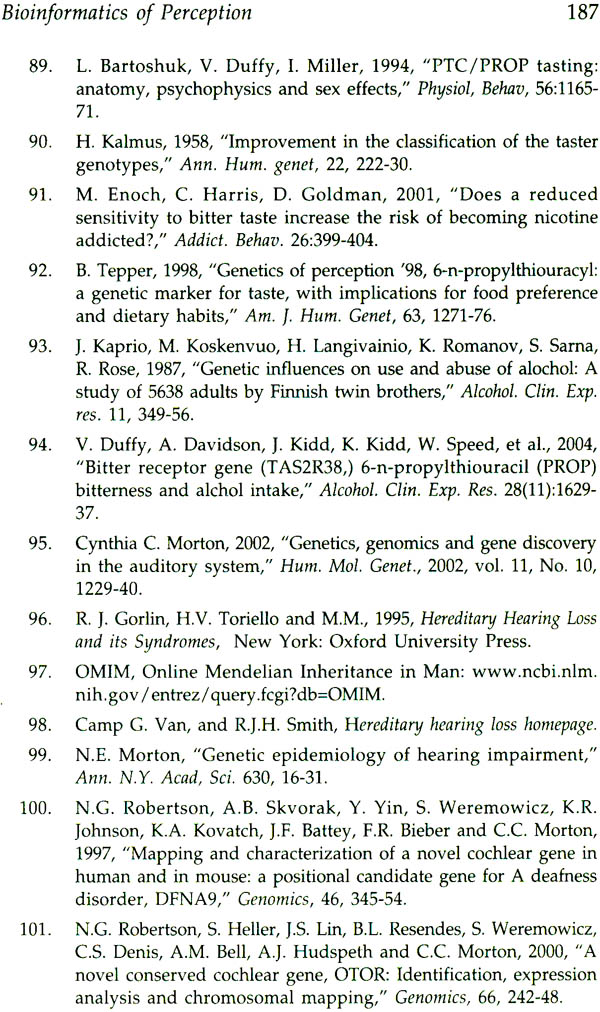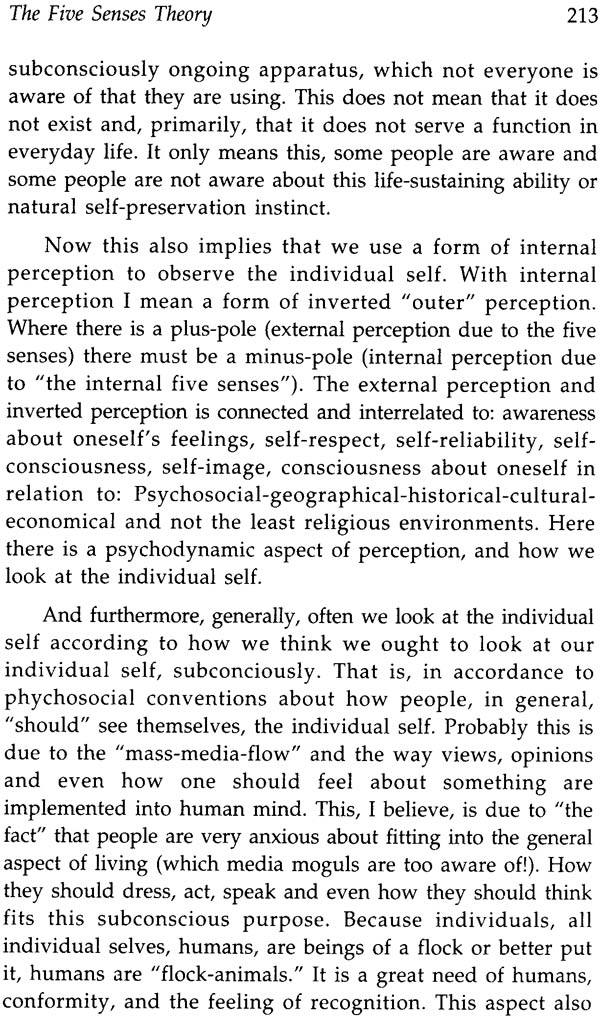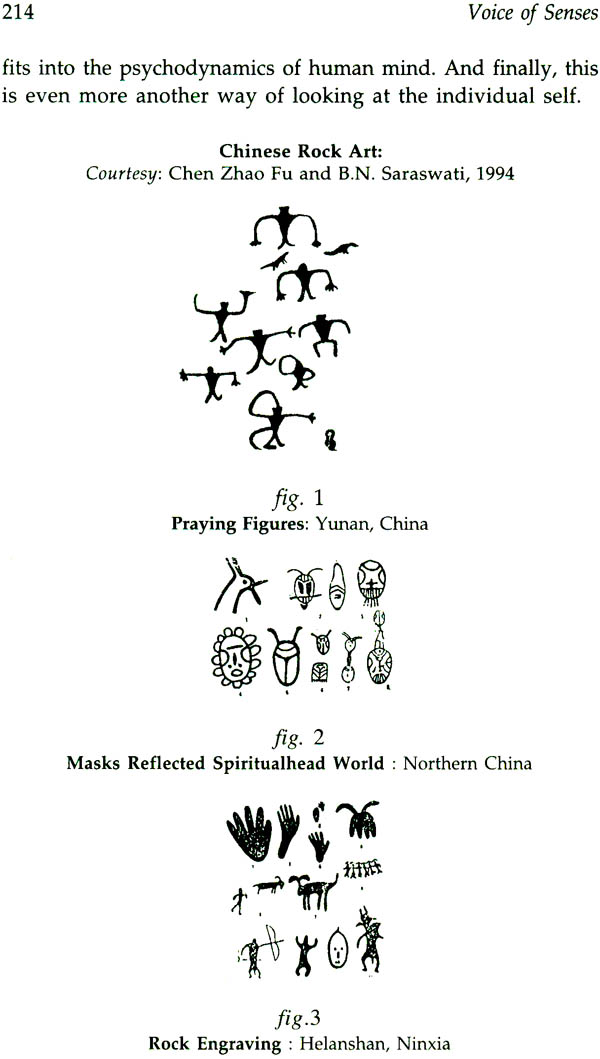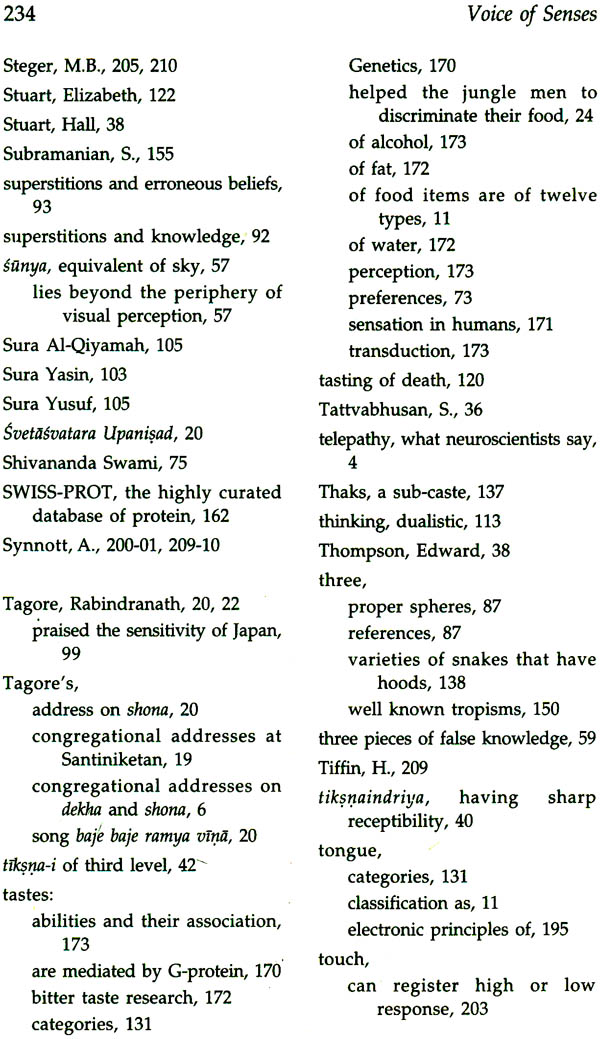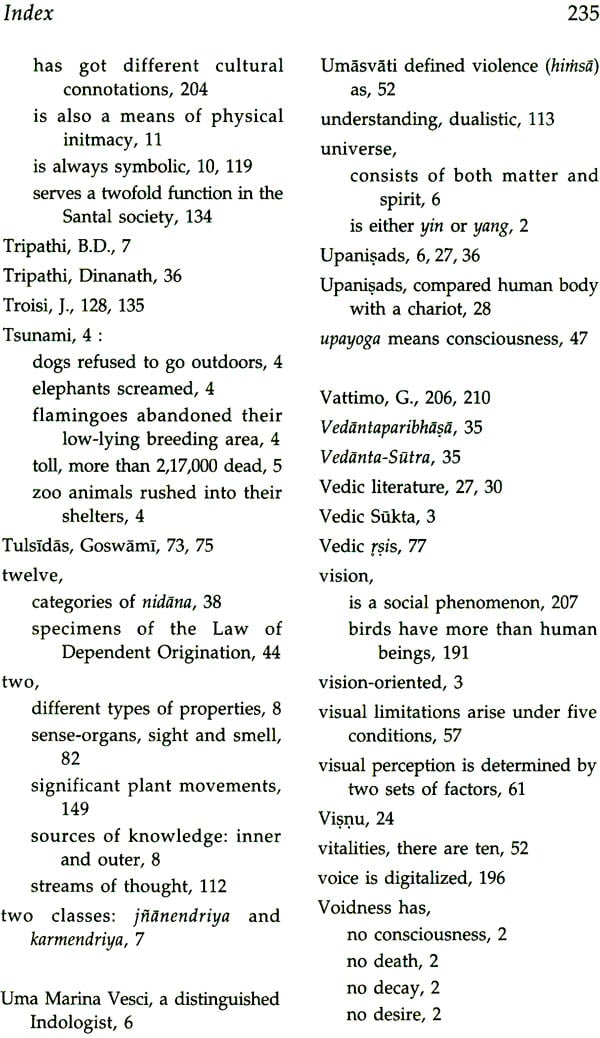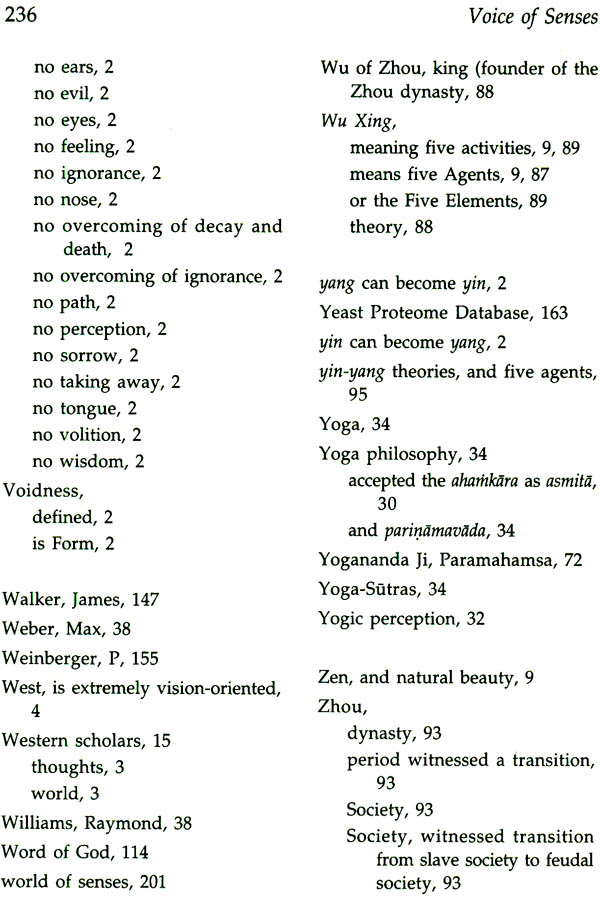
Voice of Senses Traditional Thought and Modern Science
Book Specification
| Item Code: | IDJ781 |
| Author: | Baidyanath Saraswati |
| Publisher: | D. K. Printworld Pvt. Ltd. |
| Language: | English |
| Edition: | 2007 |
| ISBN: | 8124604096 |
| Pages: | 218 |
| Cover: | Hardcover |
| Other Details | 8.6" X 5.6" |
| Weight | 500 gm |
Book Description
Introduction
The N.K. Bose Memorial Seminar on Traditional Thought and Modern Science began with the Concept of Death (November 2002), followed by the Concept of life (November 2003). Both pervade all human thinking: death symbolizes zeros, life flickers. The third in this series was devoted to the Concept of Senses (November 2004), also a universal theme, building up the chemistry of life. The recurring cycle of Five senses is a frequent one, especially in classical Chinese, Tibetan thought and Indian Philosophy.
Theme
The theory of Five Elements or Five Processes is basic to Chinese tradition. The Elements referred to are the Wood, Fire, Earth, Metal and Water. They are not so much the material substances that we would commonly associate with those Five names, as a reference to Five kinds of processes, which explain the composition of the physical world. It is really a description of how the material world forms and changes. In Chinese culture, there are Five tastes: sour, bitter, sweet, metallic and salty; Five emotions: anger, joy, anxiety, grief and fear; Five colours: blue, red, yellow, white and black; Five directions: North, South, East, West, and with obvious logic centre; and Five kinds of climate: windy, hot, dry, humid and cold. It would be more appropriate to describe the five elements as the Five Processes. The Chinese theory of yin and yang forms a harmonious whole, everything in the universe is either yin or yang the world itself, the objects in the world, the mankind, the parts of the body, the functions of those parts and the medical condition which affect those functions. Neither yin nor yang is absolute. Even the most yin thing has a small element of yang within it and vice versa. That is why the symbol of the relationship of yin and yang looks as it does. It reminds us that because yang and can become yin, according to the flux of the universe. Nothing in this world is fixed and immutable.
The Five aggregates comprehended in Tibetan Thoughts, are taken as being naturally and wholly voidness. Forms are voidness and voidness is Form, nor are forms and Voidness separable, or Forms other than voidness. In the same way, perception, feeling, volition and consciousness are voidness. Thus are all things voidness: without characteristics, unborn, unimpeded, unsullied, unsulliable, unsubtracted and unfilled Such being so, voidness has no form, no perception, no feeling, no volition, no consciousness, no eyes, no ears, no nose, no tongue, no body, no mind, no form, no sound, no smell, no taste, no touch, no quality. Where there is no eye there is no desire, there is no consciousness of desire. There is no ignorance, there is no overcoming of ignorance, there is no decay and no death, and there is no overcoming of decay and death. In the same way, there is no sorrow, there is no evil, there is no taking away, there is no path, there is no wisdom, nor any attaining, nor not attaining. The Awakened One also realized concomitantly with his awakening, that all the other dualities, such as joy and sorrow, good an evil, adding to and taking away, are merely samsarika hallucinations. So, too for such a One there is no path, nor any traverser of the path.. There is no wisdom, just as there is no ignorance, nor any attaining or not attaining of wisdom. In short, there is nothing that the unlimited mind may conceive that which has other than an illusory, dualistic existence.
The recurring cycle of Five is frequent one in Indian thought: the Five Buddha, the Five-headed Siva, the Five-coloured thread, the Five consecration, the Five lamps, the Five leaves, the Five nectars, the Five offerings, the Five precepts, and the Five products of a cow have their own explication. The Five elements referring to Earth, Water, Fire, Air and Sky are not merely insentient elements but are a combination of both consciousness as also non-conscious principles. Elements are defined in the Vedic Sukta. They have been regarded as divinities. To the Buddhists, the universal elements of matter are more energies than substances. The Abhidharmakosa explains this: The rupaskandha consists of Five sense-organs are the eye, the ear, the nose, the tongue and the tactile organ. The Five objects are the objects of these very sense-organs, namely the visible, the sound, the taste, the odour and the tangible. It is further said that the subtle material Elements (rupaprasada), conveying visual and other sensations, which ae the points of support for the respective consciousness of the visual, etc. are the Five sense-organs that organize human behaviour, develop aesthetic sense, and communicate knowledge of all kinds. The modes and matte of communication may vary from person to person, from culture to culture. Indian thought reflects a deeper concern towards "hearing" as the most exact way of communication. In fact, the entire knowledge system of the classical scholars, ranging from theology, philosophy, music and medicine (based on pulse reading), owes predominantly to the faculty of hearing.
In contrast to this, the Western thought is extremely vision-oriented. John Locke's famous dictum "the perception of the mind is most aptly explained by words relating to the sight" has proven one of the basic tenets of the empiricists in the western world. Thus, what comes out is that: whereas the East is extremely hearing-oriented, the West is extremely vision-oriented. This differential orientation of the people belonging to different cultures and civilizations invites our attention on understanding of how differently the Five sense-organs have been treated in various discipline and cultures.
This raises questions: Who sets the Five senses in order? Who is aware when a man is lost in sleep? How to we look at the individual Sleep? How do we look at the individual Self? Is consciousness a universal manifesting field? Is it the primal condition of human nature and culture? Who provides hearing and seeing? Does hearing and the seeing? Is the hearing-oriented culture superior to the seeing-oriented culture? Where is the seed of the archaic? What has modern science to say about human senses? What do neuroscientists say about the faculties of telepathy and clairvoyance? How do people acquire presentiments such as prophetic and intuitional message and remote viewing? How does an artist view the Five senses? What has Ayurveda to say about the senses? What have other researchers to say about the human feelings and emotions? Do animals have the Five senses, as in humans? Do trees have human-like vibratory patterns? Quite apart, there are non-literate people who read the nature of Nature, beyond the range of modern science. Here is an example; Before the recent massive tsunami giant waves, that slammed into Sri Lanka and India, as reported in National Geographic News (January 4, 2005) the wild and domestic animals seemed to know what was about to happen, and so they fled to safety. According to eye-witness accounts, the following events happened: Elephants screamed and ran for higher grounds. Dogs refused to go outdoors. Flamingoes abandoned their low-lying breeding areas. Zoo animals rushed into their shelters and could not be enticed to come out. The traditional belief that wild and domestic animals possess a sixth sense, and know in advance when the Earth is going to snake, has been around for centuries. A Jarwa (tribal) of the middle Andaman explained that there is a stark contrast between the amplitude and frequency of normal tidal waves and those of tsunami. The moment the first wave was spotted, the tribals knew what force was coming, and fled to the highlands. What is that knowledge which these primitives followed? It is called the sixth sense. However the gnosis of the modern masters failed. UN tsunami recovery envoy listened to the concern of victims more than 217,000 dead around the Indian Ocean on December 26, 2004.
Is our understanding of the senses set in a low key? Will the Earth give way to a ghost melee? What is going on in the celestial world? Is man capable of providing a key to the origins of life and death? Can modern science and technology create Senses without Nature (Spirit)? Voices
The voices create a climate of opinion. Reason and logic cry out in pain, but mankind has learnt not to bother too much with reason and logic. The faith determines the course of life, but at a certain movement it ceases to have determinable positions and often finds a way of moving up in two orbits. Or cling to what appears to be the substantial world, as defined in philosophy, religion, science and social life.
Philosophy and Religion
The dictionary definition of philosophy reads: "The rational investigation of being, knowledge and right conduct." The Sanskrit word for philosophy is darsana (sight), that is, "great thinking" or talking about what is "seen" and what is "unseen (?)." Grammatically, the English word "religion" comes from re-legrere, i.e. "gather," "collect". Philosophically it tends towards re-ligare, i.e. what unites, links up man to his divinity. The Sanskrit word dharma (Pali, dharma) is far more comprehensive than "religion". Derived from dhr (to hold keep, maintain), it reflects in different context, such as attributes of mind, functions of the sense-organs, duty, nature of attributes, etc.
The Voice of Senses, raised in philosophy and religion, create a climate of faith. Scripture sanctify faith. Oral tradition points out that the universe consists of both matter and spirit. The body is made up of Five Elements or Senses. The Five Processes theory is basic to traditional thought in many parts of the world. An inquiry into the Senses is such that Self experience does not drift away from traditional search for a universal principle. The philosophical thought creates" religious world-view," and holds "Perceptual experiences," determining relationship between the two.
Sitansu Ray, a man tinted with the colour of Santiniketan, points out that Rabindranath Tagore's congregational addresses on dekha "seeing", and shona "hearing" lead us to the view that there are two reciprocal and complementary rules concerning the Five senses. Tagore, the great artist and humanist, starts with the phenomena of light, the main contingent for visual perception. Light provides the necessary condition of "seeing" the wonderful world of beautiful forms, the ruper jharana, arising from the infinite ocean of beauty. The poet Tagore feels that the grand cosmic orchestration along with decoration and dancing of everything in the Universe, is surcharged with the passion of love as it were.
Uma Marina Vesci, a distinguished Indologist, takes up the ancient Indian vision of the Senses. The Vedas and the Upanisads feel with the Senses as a powerful means of growing up in the world. Here the overall details of the Senses have been appreciably expanded in terms of subject oriented studies, a remarkable shift in philosophical development.
Nirad Baran Mandal is convinced that from ancient times the sages grasped the five senses, and gave a logical foundation to consciousness and seeing, without matter. He takes up the questions of Mind: Is it jnanendriya or karmendriya? Also, there is a controversy about whether it is an indriya. Some refuse to accept Mind as an indriya. According to Gita, Mind is the sixth sense. Following Samkhya Karika, Mind is both jnanendriya and karmendriya. Buddhists and Jains also accept the Five senses.
S.K. Pathak deals with the key features of human sense-organs as described in the Buddhist Abhidharma text, analysed in the following lines: The indriyani, the sense-organs numbering six, inclusive of the Mind; ayatana, six spheres of the above; dhatu, six basis of the above sense-organs; citta-dharma, functional psychic states numbering multiple in different status of the individual Mind, or in the group-Mind; vijnana, manifold functional consciousness like visual, audio, auder cons taste, touch and the mind consciousness. A person may hold latent potential of becoming the Buddha (as the Buddhists claim). That refers to the procedure of purifying the fourfold status of psychosomatic extension, brahmavihara and the attainment of wisdom par excellence called prajnaparamita.
Bashistha Narayan Sinha reflects on the senses in Jainism, divided into two classes: jnanendriya and karmendriya. Of them, the importance is given only to the jnanendriya. Senses are knows as having different part of body, such as skin, tongue, nose, eyes, and ears. There are Five varieties of knowledge: empirical, articulate, clairvoyant, lifespan, sense of touch, faculty of speech, sense of smell, sense of sight, sense of hearing, and rationality. Different beings are having different vitalities according to the sense they possess.
B.D. Tripathi refers to Samkhya Karika, enumerating certain limitations of visual perception under the following five conditions: extremely close contiguity with the stimuli; inattention; infinitesimally of the stimuli; stimuli under cover; and identical structure of units. Visualizing the situation, the author comes to the conclusion that the ral man is neither only Senses nor only Mind, he is Senses plus Mind. At the time of birth, the human body is equipped with primary Mind Human perception is characterized with certain limitations and tendencies. Under certain conditions, human senses covey false knowledge to the Mind. Human understanding does not exclusively depend either ont eh innate faculty of Mind or on the data supplied by the sense; rather it is jointly dependent on the two sources of knowledge; inner and outer Human mind and ego are primary in their constitutions at the initial phase. Later they are metamorphosed into secondary constitutions. Consciousness precedes idea.
K.N. Sahay examines the human senses and their purpose, that is, overtaking religious thinking. Drawing from scriptures, he approaches two different types of properties: divine and demonic. Those possessed by divine character, as elaborated in scriptures, are taken as pure gift and those born with demonic properties have turbulence of senses. Religious groups, in different parts of the world, ls in divergent societies, give a unique value. This is a universal constant. The capacities of sense-organs "which are nature-born" remain essentially limited. However, the spiritual preceptor would help open the gate of knowledge.
Kalpika Mukherjee finds the functional sense-organs in aesthetic perception. Art reproduces the raw material of the world, not as they are but being touched upon with the creative genius of the artist. As far as the aesthetic perception is concerned, the involvement of only two sense-organs appears at the first instant. For example, in the case of music, the main transmitter is the auditory organ, whereas in a sculpture or painting or in dance it is the organ of sight that is mainly involved. In the first case, the melody of music, received through the ear, is relayed through the nervous system to the Mind, who is the co-ordinator of the series of sounds and the interpreter of the meaning to the connoisseur. In the latter case, also, the whole process occurs through the immediacy of the faculty of sight.
Arttatrana Nayak refers to conceptual understanding of the Five senses known to the Chinese. The concept of wu xing or Five agent is closely linked with the Chinese theory of yin yang is explaining various universal and cosmological phenomena. The term wu xing, morphologically, is a combination of two individual words: wu means "Five", and xing means "activities." Thus it means "Five activities," explained in terms of Five basic objects: Water, Fire, wood, Metal and Earth. The ancient philosophers used to regard the objectively existing natural matters as the ral and active ones, and believed that the human taste and sensation developed as a result of man's contact with those five different external worldly substances. The author becomes too philosophical, making such generalities on the growth of human knowledge, social practice and all of the strangeness of the Chinese way, as if different from the other humans.
Hikotaro Furuta introduces Japan as one of nations having the highest sensitivity in the world, precisely because of its distinguished Four seasons, each bringing beautiful sceneries. The natural environment has helped people growing up in such a beauty; their senses were sharpened, bringing out a flash of sixth sense, called kau or intuition, and cultivated depth of the Japanese culture. The people of Japan find beauty in Nature and perceived it sensitively, responding to change in nature, appreciating beauty, by using not only the sight but also the sense. Natural beauty occupies an extremely important position, such as Zen. Japanese sensitivity has been brought up with various impression stuck by Nature. However, their sensitivities have begun declining with the thought that tradition and modernity are two independent realities. The spirit in opposition to matter.
A.S Inam Shastri has developed the dual nature of senses, as reflected in Islamic philosophy. The Holy Koran puts God into the nature of Man. Man has many qualities. When he reaches the his hearning, his sight and his skin, his sense of touch, his sense of taste, and sense of smell which are specialized form of the organ of touch. All the sensory organs and all their intellectual and emotional counterparts advance us by their use, and pull us down by their misuse. They become tell-tale witness against us, if abused. The Holy Koran refers to physical, moral and spiritual state of man. The physical state signifies the uncontrollable spirit. The moral state works out the soul from grossness to virtue, and then passes out of the physical state, and becomes a moral being. In the third stage the Soul is freed from all weaknesses and frailty, and is embraced with spiritual strength. It is perfectly united with God; cannot exist in separation of Him.
D.M. Solomon takes a specific example of Christian understanding of the Five senses, as reflected in the Bible. Anthropomorphic qualities are attributed to God in the act of seeing, implying participation in people's suffering. Significance of hearing in biblical revelation is much more significance of hearing in biblical revelation is much more significant than any other sense perception. Touch is always symbolic. When Jesus heals by touch, he communicates God's power. There are some standing here who who will not taste death before they see the Son coming in his kingdom. As a personal God, He will smell the fragrance of the sacrifices offered, but only if they follow the commandments and his statues.
Physical Science and Social Science
The assertion of the ancient philosophy and religion, concerning senses, may be taken today as superstition, abstract model or at best a working hypothesis. On the other land, the "science search" and the "social experience" may be regarded today as "fact." From the viewpoint of physical science, a natural phenomenon is governed by the physical laws independent of all moral, religious and philosophical influences. The actual acceptance of scientific theories have always been a compromise between the technological and the sociological usage of science. Human conduct is influenced by social, religious and political creeds directly, while the influence of science is rather indirect. The common man is not concerned with the validation of scientific theories. Granted that these two levels of enquiry differ, the similarity can also be imagined because experiments and experiences from a general viewpoint, eventually capable of pulling down the wall.
Most people who wake up to understand the reality raise questions: What's the use of putting a man on the Moon when we see that there is enough space to live on the Earth? The believers venerate the sun, the Moon and the Stars as divinity. Onkar Prasad has classified the Santal population based on sense-organs such as the eye, the ear, the nose, the tongue and the skin. The size of the body may vary but the basic sense-organs remain the same. Each limb has a particular form but corresponding variations are found clearly and functionally. For example, the eye is the apparatus for seeing, but seeing is further classified into two types: "seeing" through eyes, and "seeing" in dreams with closed eyes which may be auspicious of inauspicious. The ear is classified into small, broad, like winnowing fan, mongoose, twisted or dog's ear. Hearing is the sense with which the sound is perceived. The nose is classified into such types as sickle-like, cave-like, flat, round and insensible. The smell of various types received through nose may be broadly classified into tolerable and intolerable. The tongue is classified into long, flat or broad, thick and rough. The tastes of food items, others than rice-beer, are of twelve types. The skin, as a sensory organ, is valued in socio-religious code of behaviour. Touch is also a means of physical intimacy between the members of opposite sex. Colour is also an important aspect of vision. The Santals have preference for the yellow colour.
Sanghamitra Pal reflects on the function of the sense-organs in the snake-catching technology of the Sapure Mal; the snake-charmers having a lower social status. The author describes all the known forms of snakes classified into broad categories: moshel with and without nazi (poison). As a good animal taxonomist, the author describes all the known forms of snakes, sorting out their relationship and habits. The dichotomous key has been used as being the simplest to work through. Complete classification of snakes, as understood from the Sapure, has been given. The Sapure's belief and observation regarding the types of snakes, their habit, mating birth and death have been recorded largely on the basis people's knowledge and experience.
Saroj Kr. Pyne and Gautam Samanta have studied animal behaviour during natural disaster vis-à-vis their role for the welfare of mankind. The case study shows that the animal's sense of smell is much more superior to that of humans. Reports of animal's sixth sense in detecting hurricanes, earthquakes, tsunamis and volcanic eruption, long before the Earth starts shaking go back to centuries. Some species behave strangely before a catastrophe. Fish are sensitive to low frequency vibrations and detect tremors long before humans. Elephants feel the quake in their feet and trunks, and they can also figure out what direction the stimulus is coming from how strong it is and what evasive action to take. Such responses from animals are helpful to humans.
Somasish Ghosh Dastidar and Menojit Debnath, present a simplified form of knowledge regarding the plant's response to external stimuli, a significant finding of Sir Jagadish Chandra Bose. One defining characteristic of life is an ability to respond to stimuli. Adaptive organisms respond to stimuli because it leads to longevity and survival. Animals have nerves and muscles. Plants also respond by growth patterns. It is possible for a plant to respond to the vibrations, accompanying sound. While there are responses to sound/vibration in plants there is no controlled study published so far on the musical test. To conclude, plants also respond to external stimuli, and growth patterns and harmony are the prime modulators of such manifestations.
S.N. Ojha deals with bioinformatics of perception which provides plausible explanation of the traditional concept of Five senses that builds up the chemistry of life, a universal home, well known in classical Chinese, Tibetan thought, and Indian philosophy. Modern science now provides the details. The ability to detect smell serves essential and aesthetic functions in vertebrates. Many species rely heavily on their sense of smell to locate food, detect predators or other dangers, navigate and communicate social information. Olfaction plays a role in mate-choice, mother-infant recognition, and signaling between members of a group. Humans may not depend on olfaction for survival to the same extent as other species, but use extensively to gather information on surroundings. Humans have taste sensitivity to different substances, some genetic in origin, and many others inter-individual differences determined by genetic mechanism. Humans can distinguish Five major taste classes; sweet, sour, bitter, salty and umani (savoury flavour) exemplified by the amino acid glutamate. The field of human taste genetics is at an exciting juncture. Biological process of hearing itself is unfolding as genes, underlying hereditary "hearing impairment." Understanding the genetic basis of hearing loss has fascinated human and medical geneticists, for decades. The frequency of hearing-loss is estimated at one per thousand new-born, and half of all cases are attributed to genetic causes. The Visual process involves a complex set of physiochemical reaction that converts light energy into neuronal signals that transmit information to the brain. The interior part of the eye (including lens, cornea, pupil, iris and cilium body) is responsible for maintaining optional conditions for light entering the eye. This involves providing a clear, well-nourished, surface with proper supporting tissue for the cornea and lens to refract the right amount of light into the retina without any interference. The posterior portion of an eye (the retina and optic nerve) is required for the conversion of light energy into chemical and electrical stimuli, and subsequent transmission of the of the sensory neural signal to the visual cortex of the brain.
Ajeya Jha and H.K.D. Sharma have taken great deal of interest in finding out how modern technology imitates the Five senses, often referred to as artificial sense technologies making use of various types of sensors. A sensor is an entity that tells something about its environment. An electronic that tells something about it environment. An electronic sensor is that which gives information about its environment by creating an electrical signal. Thus, electronic feelers design to mimic the "sense of touch," "electronic nose," electronic tongue," "electronic eye," and "electronic ear." How do they compare with the natural human sense-organs? The authors explain in a satisfactory way as to how real time application is a challenge.
Umesh K. Singh, referring to different observations, draws to a close that there is a differentiation in sense perception between the traditional man and the post-industrial man. The perceptual cognition of the traditional man and the post-industrial man. The perceptual cognition of the traditional man was more "inner-directed" which has now changed over to the "other directed" cognitive person in contemporary times, Ranging from "super individual's faculties of human sense to the artificially created and technologically added devise," the human senses have produced a wide spectrum of knowledge and cognition of reality. The intervention of technology in contemporary times has enlarged the physical and mental ability of the individual which, thought appears to be artificial and contrived. Yet helps the physically and mentally impaired to face the outer reality though providing a new contextual apparatus of knowledge. The author presents the story of socio-cultural construction of sense in post-modern society measured by Western scholars in their own imagination, taken literally as the expanding universe of knowledge.
Henrik Janne raises the questions: Who sets the Five senses in order? Nature: because in it there are codes already preprogrammed. That is, there are law of Nature is supreme, the ultimate. Nature is everything. Now, could one compare. Nature with God? The law of Nature contain the seed of the archaic.
Form the Jacket
The volume is devoted to a through understanding of the concept of senses as it has been interested in the ancient Asian traditions with particular references to Indian religious and philosophical throught. It examines the perception of them adopting a sociological and scientific The first part of the presentation comments on the recurring cycle of five Senses in Chinese, Tibetan and Indian philosophy. It takes up ancient knowledge on the sense can be gained from the Vedas and he Upanisads, the Buddhist Abhidharma text and Jainism, as also from Islamic and Christian philosophies. They relate functioning of the sense-organs to aesthetic perception.
Articles in the second part examine ethnic-cultural communities responses to sense and attribution of functions to them, as, for instance, the importance attached to the senses by the traditional snake-charmers. They study responses by plant and animal life to their environment and inquire into the biological process involved in sense perceptions. Modern technology is discussed as imitating the five Sense.
These articles should be of benefit to scholars interested in learning about the different aspects of Indian religious and philosophical perceptions.
Baidyanath Saraswati, an anthropologist, has spent some four decades in unraveling the relationship between traditional thought and modern science. He is known to a wide public for his ambitious attempt to make sense of Hinduism, an extremely complex religion. His works on Brahmanic Ritual Traditions; Kashi: Myth and Reality; Spectrum of the Sacred; The Eternal Hinduism; and Cultures and Cosmos are major contributions.
| | ||
| Transliteration Chart | ix | |
| Introduction - Baidyanath Saraswati | 1 | |
| Philosophy and Religion | ||
| 1. | Tagore's Congregational Addresses on Seeing and Hearing Sitansu Ray | 17 |
| 2. | The Senses - Uma Marina Vesci | 23 |
| 3. | The Five Senses Theory: Indian Approach - Niradbaran Mandal Kavyatarkatirtha | 27 |
| 4. | Human Sense-Organs: As Described in the Buddhist Abhidharma S.K. Pathak | 37 |
| 5. | Senses in Jainism -Bashistha Narayan Sinha | 47 |
| 6. | Senses and Human Understanding -B.D. Tripathi | 55 |
| 7. | Human Senses and Their Purpose K.N. Sahay | 65 |
| 8. | Function of Sense-Organs in Aesthetic Perception -Kalpika Mukherjee | 77 |
| 9. | Conceptual Understanding of "Five Agents" (Senses) in Chinese -Arttatrana Nayak | 87 |
| 10. | Sensitivity of Japan -Hikotaro Furuta | 97 |
| 11. | Dual Nature of Senses: Islamic View- A.S. Inam Shastri | 101 |
| 12. | Christian Understanding of Five Senses D.M. Solomon | 107 |
| Science and Society | ||
| 13. | Santal Perception of Organs and the Senses - Onkar Prasad | 125 |
| 14. | Function of the Sense-Organs in the Snake-catching Technology -Sanghamitra Pal | 137 |
| 15. | Animal Behaviour During Natural Disaster: and Their Role for the Welfare of Mankind -Saroj Kr. Pyne and Gautam Samanta | 145 |
| 16. | Plant Response to External Stimuli -Somasish Ghosh Dastidar and Manojit Debnath | 149 |
| 17. | Bioinformatics of Perception -S.N. Ojha | 157 |
| 18. | Modern Technology to Imitate Five Senses -Ajeya Jha and H.K.D. Sarma | 191 |
| 19. | Socio-cultural Construction of senses and Post-modern Society -Umesh K. Singh | 199 |
| 20. | The Five Senses Theory -Henrik Janne | 211 |
| The Contributors | 215 | |
| Index | 217 |
